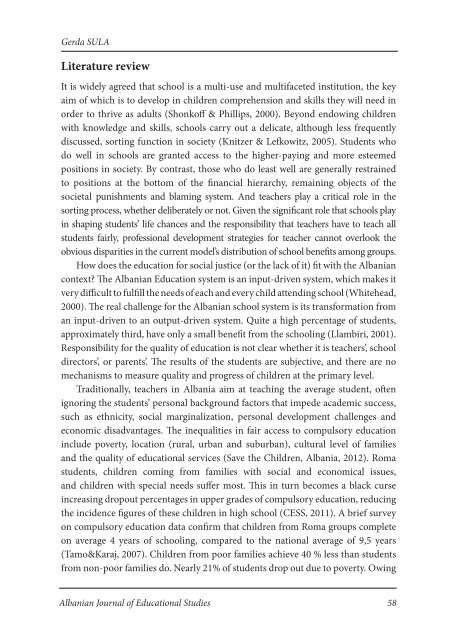Download - qendra per arsim demokratik
Download - qendra per arsim demokratik
Download - qendra per arsim demokratik
Create successful ePaper yourself
Turn your PDF publications into a flip-book with our unique Google optimized e-Paper software.
Gerda SULALiterature reviewIt is widely agreed that school is a multi-use and multifaceted institution, the keyaim of which is to develop in children comprehension and skills they will need inorder to thrive as adults (Shonkoff & Phillips, 2000). Beyond endowing childrenwith knowledge and skills, schools carry out a delicate, although less frequentlydiscussed, sorting function in society (Knitzer & Lefkowitz, 2005). Students whodo well in schools are granted access to the higher-paying and more esteemedpositions in society. By contrast, those who do least well are generally restrainedto positions at the bottom of the financial hierarchy, remaining objects of thesocietal punishments and blaming system. And teachers play a critical role in thesorting process, whether deliberately or not. Given the significant role that schools playin shaping students’ life chances and the responsibility that teachers have to teach allstudents fairly, professional development strategies for teacher cannot overlook theobvious disparities in the current model’s distribution of school benefits among groups.How does the education for social justice (or the lack of it) fit with the Albaniancontext? The Albanian Education system is an input-driven system, which makes itvery difficult to fulfill the needs of each and every child attending school (Whitehead,2000). The real challenge for the Albanian school system is its transformation froman input-driven to an output-driven system. Quite a high <strong>per</strong>centage of students,approximately third, have only a small benefit from the schooling (Llambiri, 2001).Responsibility for the quality of education is not clear whether it is teachers’, schooldirectors’, or parents’. The results of the students are subjective, and there are nomechanisms to measure quality and progress of children at the primary level.Traditionally, teachers in Albania aim at teaching the average student, oftenignoring the students’ <strong>per</strong>sonal background factors that impede academic success,such as ethnicity, social marginalization, <strong>per</strong>sonal development challenges andeconomic disadvantages. The inequalities in fair access to compulsory educationinclude poverty, location (rural, urban and suburban), cultural level of familiesand the quality of educational services (Save the Children, Albania, 2012). Romastudents, children coming from families with social and economical issues,and children with special needs suffer most. This in turn becomes a black curseincreasing dropout <strong>per</strong>centages in up<strong>per</strong> grades of compulsory education, reducingthe incidence figures of these children in high school (CESS, 2011). A brief surveyon compulsory education data confirm that children from Roma groups completeon average 4 years of schooling, compared to the national average of 9,5 years(Tamo&Karaj, 2007). Children from poor families achieve 40 % less than studentsfrom non-poor families do. Nearly 21% of students drop out due to poverty. OwingAlbanian Journal of Educational Studies 58


